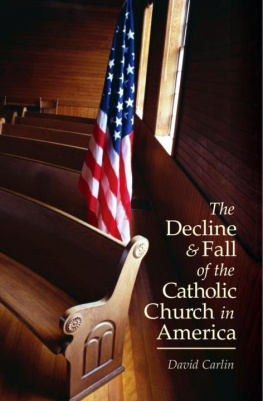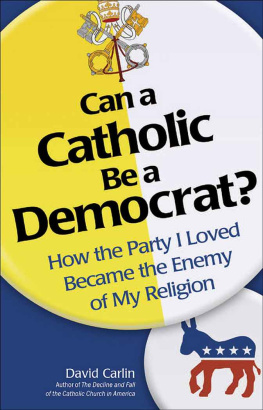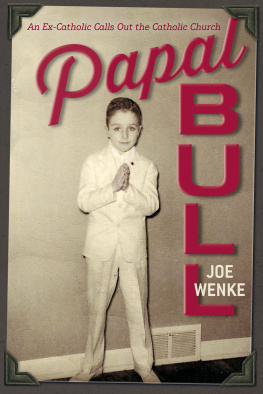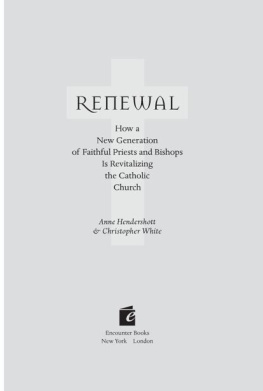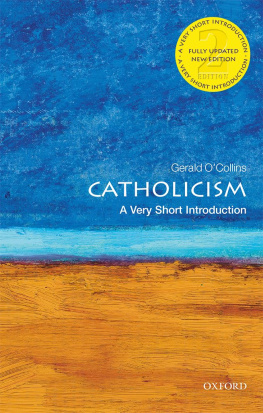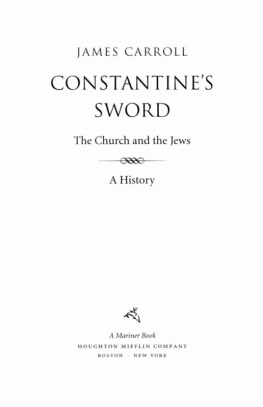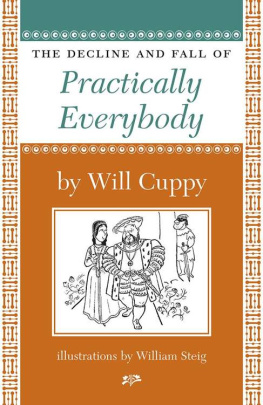David Carlin




................. 3
Part I: The Great Transformation
............. 37
......... 51
....... 67
Part II: Philosophical Undercurrents of the Great Transformation
...... 75
..... 83
...... 91
...... 105
Part III: Evolution of a National Religion
... 113
... 117
................ 145
Part IV: The Deeper Problem of Catholic Identity
....... 163
................ 183
.............. 187
...... 195
Part V: The Search for a National Moral Consensus
....... 211
... 225
............ 249
Part VI: The Decline and Fall of the Catholic Church in America
. 261
....... 297
Part VII: Can the Fall Be Prevented?
........ 335
.. 349
................. 363
.......... 377
Appendixes
.............. 389
.. 393
........ 407
The Great Catholic Sex Scandal of 2002 - a twofold scandal that involved priests molesting minors and bishops covering up for many of the molesters - was in more ways than one merely the tip of the iceberg.
In one way, it corroborates the suspicion that many people have had for a long time namely, that homosexuality is rife in the American Catholic priesthood. If this is true, it is a deeper and even graver problem than the tremendous problem of criminal sex abuse. For a Catholic Church led by a priesthood that is twenty or thirty percent (or more) homosexual is simply not going to work.
But there is a still deeper problem, of which the widespread homosexuality, the molestation, and the cover-ups are merely symptoms. The root problem is that the Catholic Church in the United States has largely ceased to be Catholic. A few decades back, it quietly hung its Catholicism in the closet and put on an attractive new garment, that of generic Christianity or Christianityin-general. The new garment is more "modern," more "American," and more lightweight, suitable for the hustle and bustle of the contemporary world. (Of course, the old garment was not destroyed; it was only hidden away. This means it can be taken out and donned on certain ceremonial occasions, and it can be dusted off and held up to rebuff someone who asserts - as I do - that the Church in America has largely abandoned its Catholicism.)
This book is an attempt to explore and analyze this deeper problem.
In some ways, I confess, I personally find "generic Christianity" an attractive ideal. After all, it is very tolerant, and tolerance is a great and important American virtue, and I myself am a thoroughgoing American. So how could I not find the ideal attractive? Besides, I have spent many years of my life as a politician, and politics in America is not an especially ideological sport. For the most part, the American political animal is a thoroughly practical animal, not troubling to explore and debate the doctrinal underpinnings of action. Christianity-in-general, which abstains from splitting doctrinal hairs, is just the kind of religion that would appeal to the nondoctrinal political mind.
But I am not only an American and not only a politician. I am also a Catholic with an interest in history and sociology. As such, I have become convinced that generic Christianity (or, as it may also be called, "liberal Christianity"), attractive though it may be in the short run, is, in the long run, fatal for any church that embraces it. Once any church begins shedding its unfashionable dogmas, it finds itself unable to stop; it has set foot on a slippery slope. First this dogma will go, then that one, and then another, until finally the church has no dogma left - only a gentle wish: "Can't we all just be nice to one another?"
Long before reaching that zero-point, most people will come to realize that there is no reason to belong to this church rather than that church; indeed, there is no real point in belonging to any church at all. For American Catholics to embrace generic Christianity, then, is to embrace gradual institutional suicide.
One may ask, "What's wrong with everybody being nice to everybody else? If generic Christianity terminates in such a fine attitude, isn't that a consummation devoutly to be wished?"
Maybe. But the trouble is, everybody will not end up being nice to one another. The churches that remain open on Sunday mornings will preach niceness to their few remaining members, but in the meantime, the religious vacuum in society will have created a moral vacuum, and who knows what monsters will rush in to fill those vacuums? The nineteenth-century decline of religion in Europe, especially among European intellectuals, was followed in the twentieth century by Communism and Nazism. The decline in American religion that began in the 1960s was soon followed by the widespread practice of abortion, which has been taking place at the rate of more than one million per year for the last thirty years.
Although, as I have already revealed, I am not an impartial observer of developments in American Catholicism, I have honestly tried to write this book - well, the first twenty-six chapters of the book, after which I become frankly partisan - as though I were an impartial observer. I have tried to write a piece of pure sociology, the kind of thing that could have been written by someone completely indifferent to Catholicism. It is not, however, a piece of empirical sociology; that is to say, I have done no original research, nor uncovered any facts that are not commonly known to anyone familiar with the Church in the United States.
Rather, it is an essay in sociological interpretation. I have taken certain "common knowledge" facts about American Catholicism and about the United States as a whole, and I have tried to link them together in a coherent pattern that explains what has happened to American Catholicism in the last forty years. After arriving at some very pessimistic conclusions about the future of the American Church, I have added a few more chapters in which I look - perhaps not very successfully - for grounds for hope and optimism.

